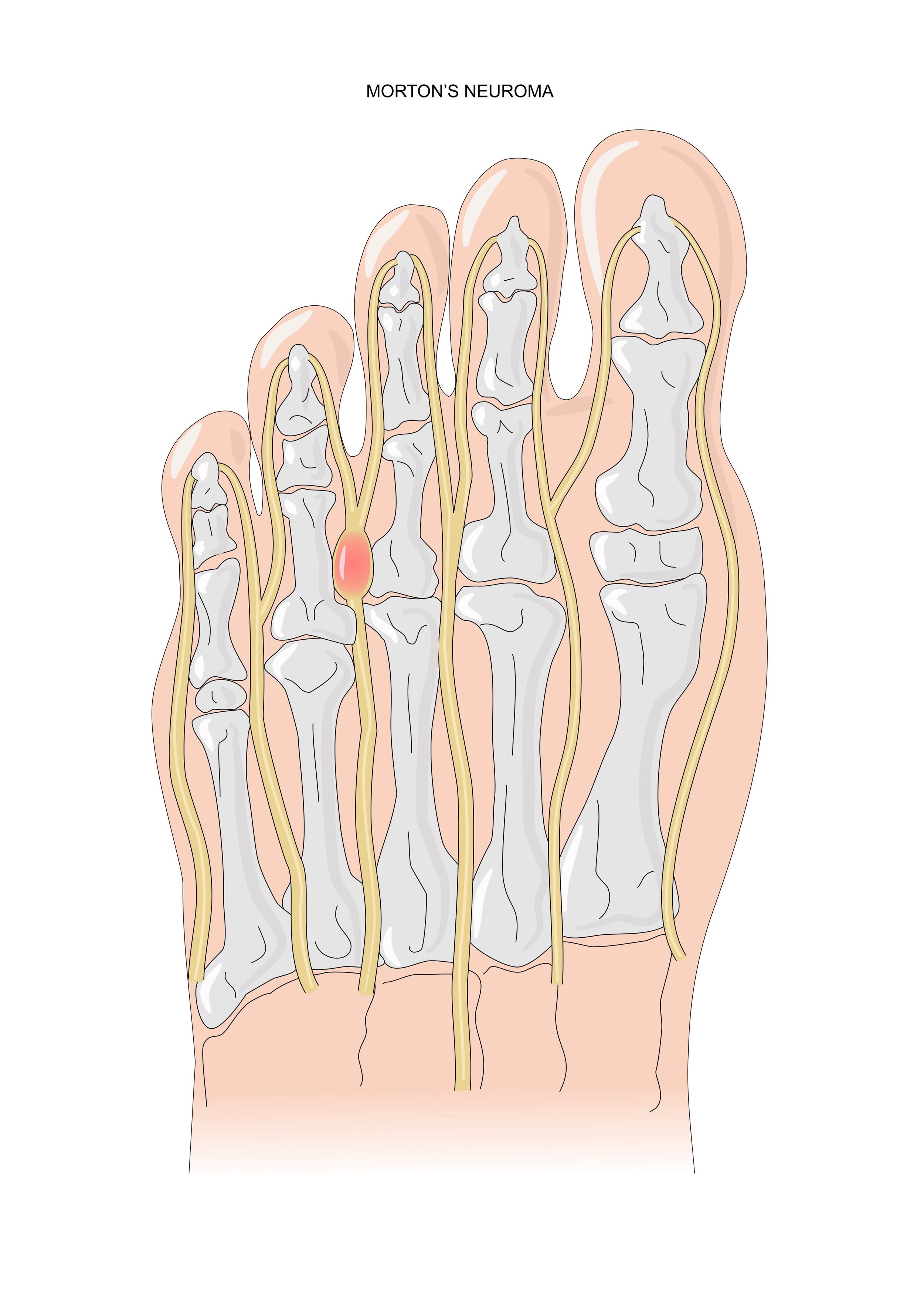Neuroma
(Morton’s Disease)
A neuroma is a benign tumour in nerve cells. In the case of Morton's Neuroma the tissue, around one of the nerves that leads to the toe, thickens hence causing a sharp, burning pain in the ball of the foot. It is referred to as the ‘inter-digital” neuroma because of its common position between 3rd and 4th toes.
Symptoms
Each person who has a neuroma may have different degree of symptoms but the one thing that most everyone has is pain when bearing weight on the foot
The type of pain people can experience varies. Some say it feels like you are standing on a fold in your sock or on a pebble in your shoe while others have shooting pain that affects the contiguous halves of the two toes. Some even say it can feel like walking on razor blades
Pain under the ball of the foot. This dull pain, that can be described as similar to an electric shock, between 3rd and 4th toes generally. Typically, the affected person will experience sudden pain while walking and will have to stop to remove shoes
Burning that radiates to the toes
Paraesthesia (numbness) felt as ‘pins and needles’
A sensation that something is inside the ball of the foot
More acute pain may be experienced when tight narrow or high-heeled shoes are worn or during high impact activities or when walking or standing.
Causes
The constant abuse to the nerve branch is a primary factor associated with formation of neuromas. The imbalance in the structure of the foot, makes the foot unstable. This causes an abnormal motion of the foot. Over time the soft tissue adaptation stimulates the thickening of the nerve. Sometimes the nerve becomes entrapped and becomes inflamed due to constant irritation from the surrounding bony structures.
Foot conditions where the bones rub against a nerve may include:
Feet pressured inside the gravity of high-heeled shoes, especially over 5cm, or pointed or tight, which squash the toes together. (more commonly in females)
A high-arched feet are more prone.
Flat feet, where nearly the entire sole of the foot is flat to the ground
A bunion, which enlarges the joint.
Hammer toe (deformity of proximal interphalangeal joints of 2nd, 3rd or 4th toe) cause permanent bend.
High-impact activities like running, karate or court sports that place undue pressure on the feet.
Foot injuries or foot trauma may lead to a neuroma.
Treatments
TREATMENT
Whatever the cause, treatment will be necessary at some stage. Your podiatrist will start treatment of a neuroma with a conservative approach by addressing the causative factors, namely:
Reduce inflammation with rest, elevation, ice and massage with anti-inflammatory gels, like naproxen (Aleve) or ibuprofen (Motrin IB or Advil) to help with the pain and reduce swelling.
Massage your feet with ice by rolling a cup of frozen water over the painful site to help reduce the pain or apply a cold pack to the area for 10-15 minutes for 3-4 times each day.
Take a break from activities like dancing, aerobic exercise, or jogging that can subject your feet to repetitive motions.
Footwear Assessment to ensure shoes do not place lateral pressure on the bones, as pressure will heighten the irritation to the nerve. This may also entail the removal of foot wear as much as possible. But either way you will need to wear shoes with a lower heel so you are not putting all that weight on the front of your foot and ones that are a little wider at the toes.
Pad or tape the affected area or wear arch supports that you can purchase over-the-counter or have prescribed in customized form for your foot
Address the foot and lower limb biomechanics, which involves diagnosing the cause of the foot instability and prescribing customised orthoses to separate the toe bones and stabilise the foot.
Anaesthetic injection is done when the above treatments are insufficient, because the trauma to the site is so high that more support is needed to control the inflammation. If cortisone injection is the preference, then ultrasound guided injection could be done
Surgery: Surgery is the only way to eliminate the swollen nerve. But before surgery is done all other treatments will be tried. Two different surgeries that can be done include: Excising an entrapped nerve which requires an incision in the top of the foot. It is possible at times for the surgeon to use decompression surgery, to relieve the pressure on the nerve, by cutting the nearby structures like the ligament in the front of the foot that binds together some of the bones. Obviously with any surgery, the results are permanent and not without some side effects. Your Podiatrist will discuss this option and its side effects if necessary.
Answering your questions and concerns about painful bursitis, is important to MyFamilyPodiatrist. We want you to be in the best position to actively achieve your needs and make a speedy recovery.
Whatever approach is needed to improve your condition, it will be a shared journey between you and our podiatrist, with your wellbeing central to the process.
Take the first step!


